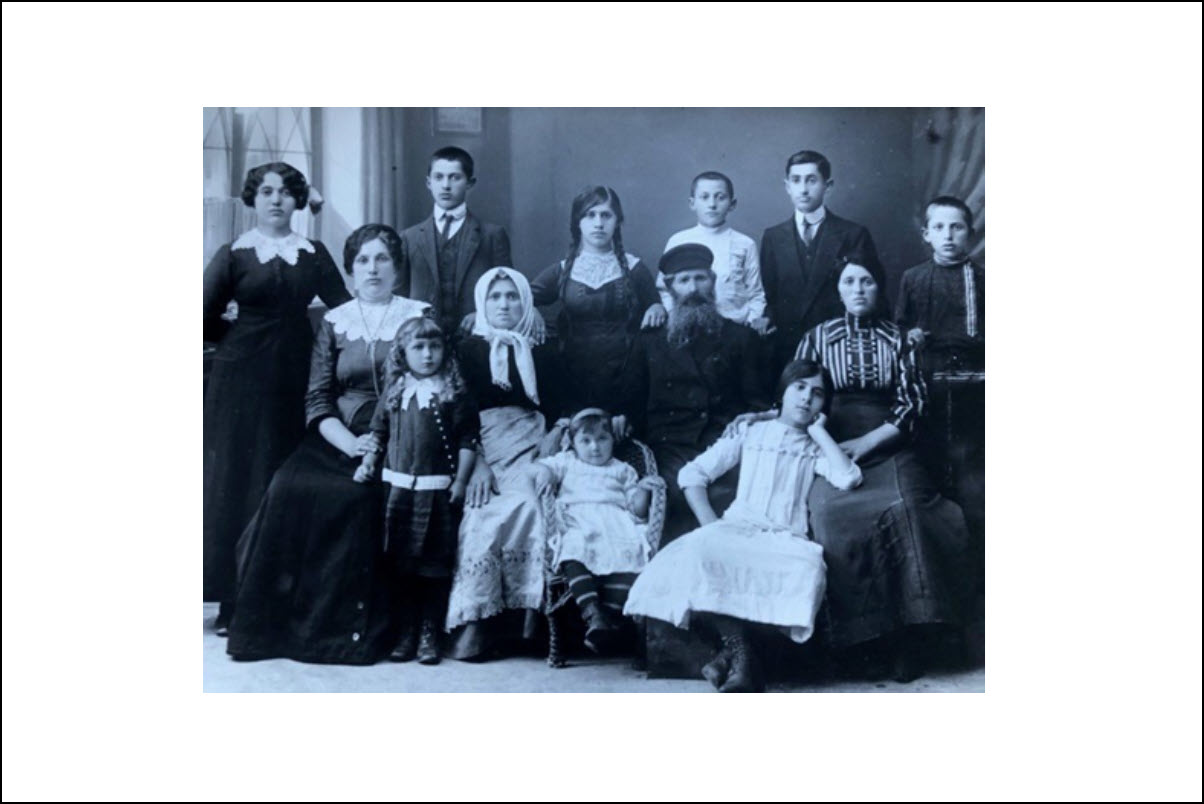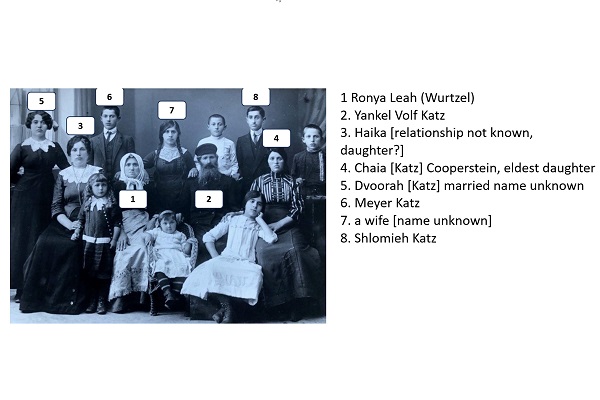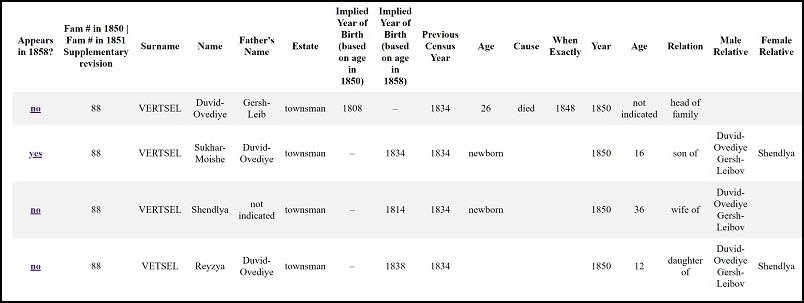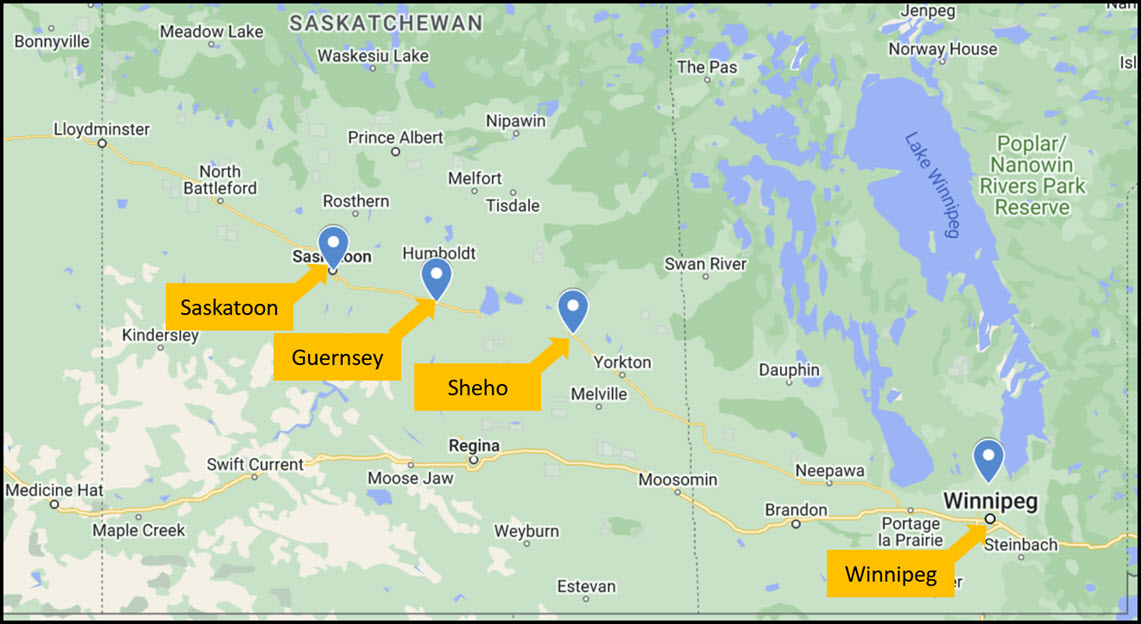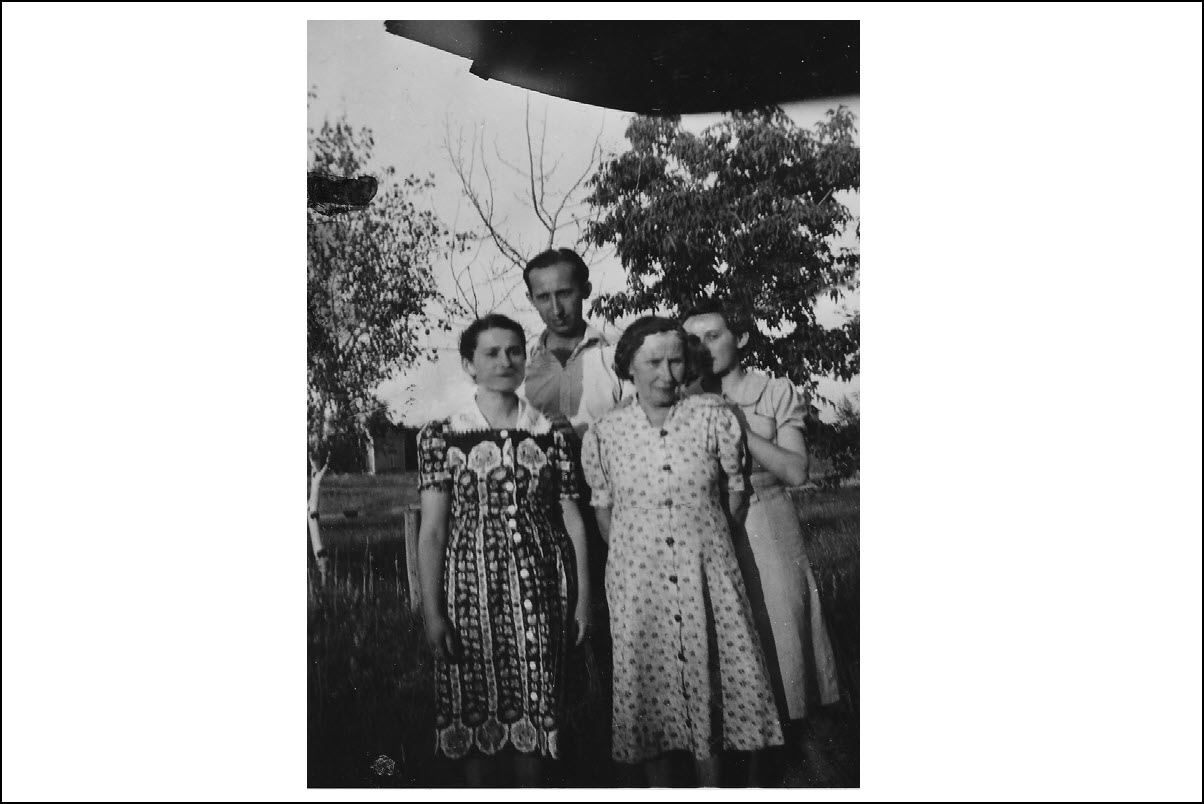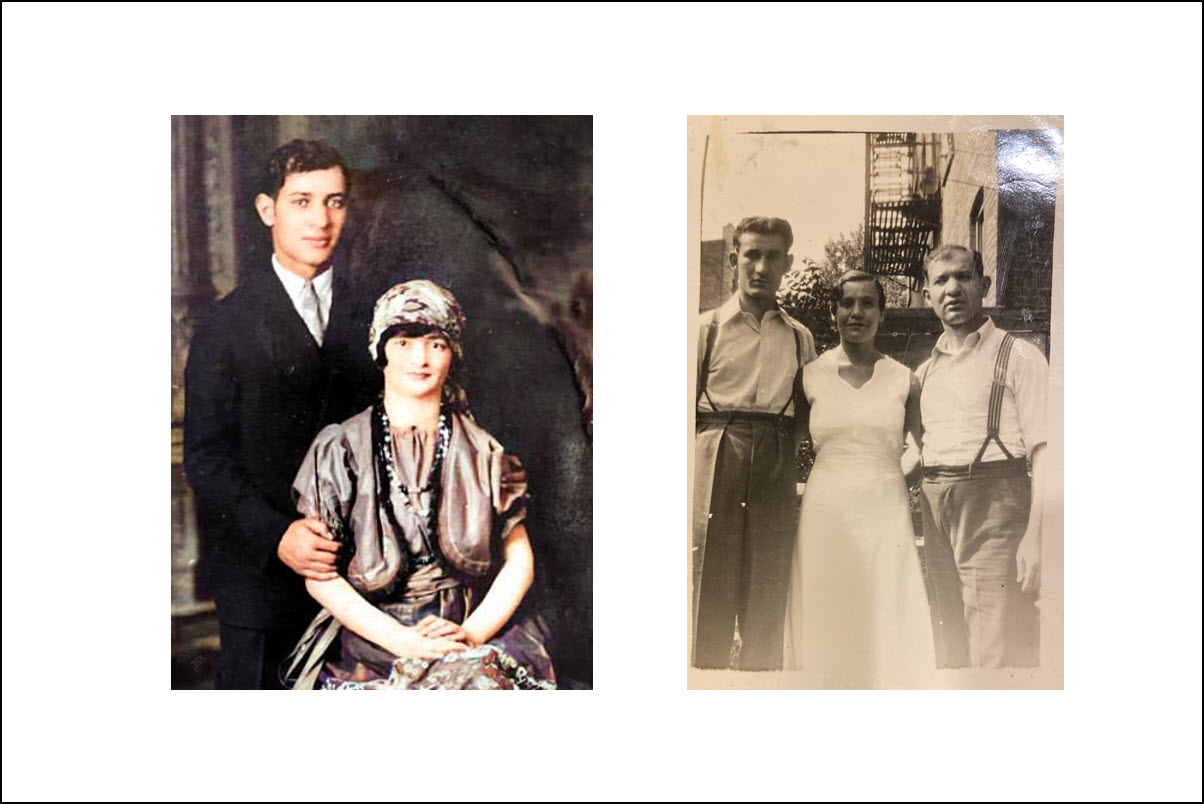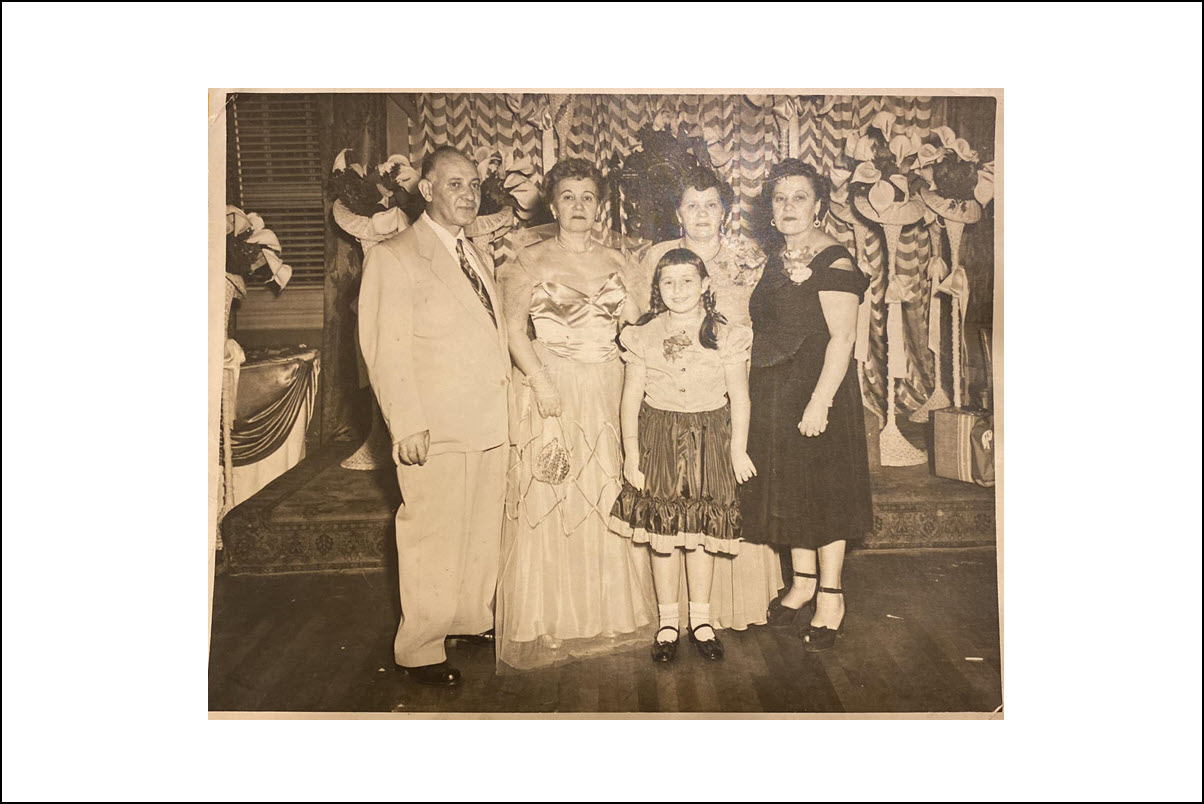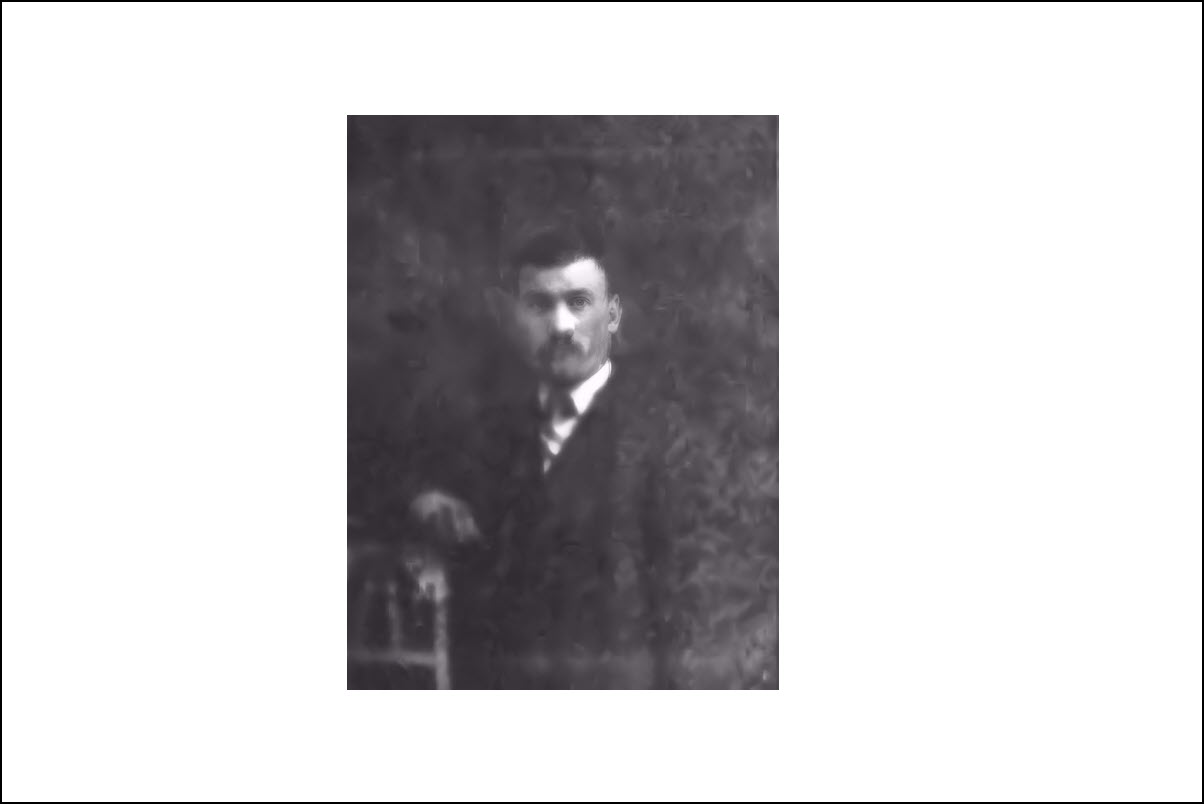-
Home
Home About Network
- History
Nostalgia and Memory The Polish Period I The Russian Period I WWI Interwar Poland 1944 Memorial Commemoration- People
Famous Descendants Families from Mlynov Ancestors By Birthdates- Memories
. The Wurtzel Family from Mervits

***
(Back to the beginning ...)
The Wurtzel Family Story (continued)
We don’t know much about the Wurtzel family from the period before their migration began. It appears that the Wurtzels may be one of the families listed in the 1850 and 1858 revision lists for Mervits which is now located and translated. In Russia, “Revision Lists” were census like documents that captured details about families for the purposes of taxes and military conscription. The details for the 1858 “Vortsel” family do not exactly match memories preserved by Wurtzel family descendants, but they are so close that it seems highly probable this is the same Wurtzel family.
In the 1858 record, a family called “Vortsel” is lised in household #87. The household includes a one-year-old child named “Rotya-Leya." As noted earlier, one line of Wurtzel descendants trace themselves back to an ancestor remembered as "Ronya Leah Wurtzel," who was a daughter of a Doovid and Meerel Wurtzel. In this record, the name of "Rotya-Leya's" mother is Mirlya (similar to Meerel). She is age 23 with an implied birth year of 1835. The husband’s name, however, does not match the family oral tradition. He is listed here as Sakhar-Moishe (Yissachar? Moshe), age 24, born in 1834. He is head of the family in 1858. Although his name is not the “Doovid” of the family memory, it seems significant that the name of this man's father name was “Duvid-Ovediye.” In keeping with the traditions of the time to use patronyms, Sakhar-Moishe is also listed in this record as “Sakhar-Moishe Duvid Ovediyev." In other words, Sakhar was “Duvid’s son” and “Duvid” was used as part of his name. This could explain why the descendants remember him as “Duvid.”
When we turn from the 1858 revision to the earlier 1850 record eight years earlier, we see that this same family surname is transliterated “Vertsel” and is clearly the same family. In that year, “Duvid-Ovediye Vertsel” is listed as head of the family. He was the son of a man named "Gersh-Leib." In a story told below, the name “Leib” was added to the name of Ronya Leah'son Louis (called Shmuel “Leib”) Katz, lending further grounds for assuming this may be the same family line and that he was a namesake of his great-grandfather, "Gersh-Leib."
According to this record, “Duvid-Ovediye” died in 1848 at the age of 40, implying his year of birth was 1808. His wife’s name was Shendlya and she was born in 1814. Her birth surname is not given. Their son, called here "Sukhar-Moishe" (a variation of "Sakhar-Moisha" in the 1858 record), was born in 1834 when his father Duvid was 26 and his mother Shendlya was 20. The record suggests they were already living in Mervits by this time. When Duvid died in 1848, their son Sukhar-Moishe was only 14 years old.
***
A Brief Look at the Three Wurtzel Lines
As noted above, descendants recall that Doovid and Meerel Wurtzel had three children. Ronya Leah, Soorkeh (Sura), and Zailek. What follows is a brief summary of each of these children’s lines: Ronya Leah Wurtzel's Line | Soorkeh (Sura) Wurtzel's Line | Zailek Wurtzel's Line. More detail is provided in the longer version of Wurtzel Family Story which can be dowloaded below.
***
Ronya Leah Wurtzel and Yankel Volf Katz
Ronya Leah married a man named Yankel Volf Katz (HaCohen) sometime before 1881. Descendants pronounce the surname “Katz” with a long “a” as if it rhymes with “dates” as grandson Jack Kates explained in a book he wrote about growing up on the Canadian Prairie. It is not known why the family pronounced Katz this way—whether it reflects the original Hebrew/Yiddish pronunciation (e.g. כץ) or was an effort at anglicization.
It is uncertain where Yankel Volf Katz was born since a family named Katz does not appear in the 1850 or 1858 revisions for either Mlynov or Mervits and very little about his family or background is recorded in family memories. However, there were a number of Katz (e.g. כץ) individuals in Mlynov who were martyred during the Holocaust and could be related to Yankel Volf. Only one shared memory of Yankel Volf Katz seems to have been remembered by grandchildren Merle (Katz) Gould and Jack Kates. Both were told or recall that he was scholar. Merle gives a bit more detail in her very brief history:
Ronya Leah, who married Yankel Volf Katz, also owned a linseed mill, and lived in Maervitz, Russia, which was close to the Polish border. Her husband, [Yankel Volf] HaCohen, was a descendant of the priestly tribe of Aaron and a dedicated biblical scholar. He spent more time in studying than in trying to make a living for his large family. It was eventually left to his sons to support the family.
Merle and Jack ascribe a different number of children to their grandparents, Ronya Leah and Yankel Volf. Merle writes that "Of their nine children, five emigrated to the United States and Canada, and four remained in Russia." In his book, Jack Kates says they produced twelve children. The Wurtzel family tree (done by Merle’s daughter Anita) and the “Very Brief History” list nine Katz children in presumed birth order: Chaieh (married name Cooperstein), Bayla (married anglicized name Bella Cohen), David, Maurice (“Moishe”), Louis (“Shmeil Lieb”), Bessie (“Pessie”–married name Shnider), Dvorah [married name unknown], Shlomieh, and Meyer. A photo of the family (see top of the page) also includes another woman who is remembered as "Haika,” who could conceivably be one of the other 12 children whose names are no longer remembered.
Since Ronya Leah was born in 1857 according to the Russian revision, it is likely she married Yankel Volf by about 1877, which is consistent with the birth dates of four of their children in the 1880s. Four of those children migrated to the Canadian prairie in Saskatchewan, Canada: David Katz (1883–1926), Maurice (Morris) Katz (~1885–1918), Louis (“Shmeil Lieb”) Katz (1887–1954), and Bessie (Pessie Katz) Shnider (~1891–?).
They settled in small villages of Sheho and Guernsey along a train route between larger cities of Winnipeg and Saskatoon, a route that had only recently begun to develop in the Canadian province of Saskatchewan. Whether they migrated with the intention of settling there or only learned about the developing opportunities along the Canadian Pacific Railway after they arrived is not known. But here, in these small villages where there was only one other Jewish family if they were lucky, they set down roots and made their life. Were they aware of the irony that these tiny villages were as small as if not smaller than the shtetl they left?
David Katz's Migration
David Katz, the eldest son (and third child) of Ronya Leah and Yankel Volf, was the first to migrate to Canada in about 1907. He followed Freida Cramer, his future wife, and one of her brothers to Canada. From a family letter written by Frayda's daughter to relatives, we know that Frayda Cramer (1883–1960) was living in Mervits before she and her future husband David Katz migrated to Saskatoon, Canada in about 1904. While there are "Kremer" families listed in the Mervits revision lists (see for example household #70) there is no certainty that Frayda Cramer were born there.
David was born in ~1883 in Russia, probably in Mervits, and died on April 3, 1926 in Guernsey, not far from Saskatoon, in the Province of Saskatchewan, Canada. Three of David’s siblings, Louis [Shmeil Lieb], Maurice [Morris/Moshe], and Bessie [Pessie] (married name Shnider,) followed David to this area of the Canada prairie and the rural life in Canada shaped their lives and the lives of their children.
David's Siblings Arrive
It is not entirely clear when David Katz’s siblings arrived in Canada. According to the “Very Brief History,” David’s brother, Louis Katz (Shmeil Leib) came to Winnipeg, Canada between 1912–1916. Not long after arriving, he found employment as a salesman working for a Mr. Dashevsky in his store in Theodore, Saskatchewan. He soon managed to save and borrow enough money to start his own business as a general store proprietor in Sheho, Saskatchewan, Canada. His brother Maurice (Morris/Moshe) Katz, worked with him and their sister, Bessie, kept house for them.A somewhat different account that offers more details was written by Louis’s son (and Merle’s brother), Jack Kates, who was born in a hospital in Winnipeg in 1928 and grew up in Sheho. Jack was named for his grandfather Yankel Volf Katz. In addition to a short family narrative, Jack wrote about his experiences growing up on the Canadian prairie, in his book Don’t You Know It’s 40 Below. The book provides a charming window into life in a small village for a Jewish family who is still speaking Yiddish, trying to keep kosher but is miles from most other Jews.
In the latter part of the nineteenth century, Yankel Volf Katz, a rabbinical scholar in the tiny hamlet of Mervits, in the Ukraine, and his wife Ronya Leah, produced twelve children, one of whom, named Schmeel, was born in 1886 or 1887. While the infant lay deathly ill, special prayers were held for him, pleading with God to let him live. In exchange, he was given another name “Leib,” meaning “to live.” He survived, and in 1912, along with his younger sister Bessie, he followed in the footsteps of his older brothers David and Moishe, and emigrated to Canada where Anglo immigration officers, who frequently had difficulty with non-English names, gave him the name of “Louis,” pronounced “Louie.” (p. 4).
Sheho, like Guernsey, was a tiny village, not so different in fact from Mervits back in Russia with one big exception. The Katzes were one of only two Jewish families in town. Jack describes Sheho as a farming village of about seventy families totaling approximately 350 people. The big claim to fame according to Jack’s narrative was that it had four and not three grain elevators which were a status symbol on the Canadian prairie. Jack has a number of other quaint memories about the layout of the small town and memories of incidents that occurred during his childhood growing up there, including memories of his parents speaking Yiddish, trips on the train to visit family in Manitoba, getting their first radio, and the time he was allowed to have non-kosher chicken soup because he was anemic and his family couldn’t get a daily kosher chicken for fresh soup (p. 37).
In a separate family narrative shared with me by descendants, Jack adds some other details.
My father, Louis Katz (pronounced Kates as in Dates), was a Saskatchewan pioneer, who owned one of Sheho's earliest general stores--from 1914 until 1947--when he moved away to Winnipeg. He was born in a tiny village in the Ukraine around 1887, one of twelve siblings, two of whom--David and Maurice--had already settled in Saskachewan. In 1912, he and his younger sister Bessie also migrated to Saskatchewan.
Louis Katz first went to Theodore [Saskatchewan] where he worked in Dashefsky's Store for two years. In 1914 he and his older brother Maurice pooled their savings of $600.[00] to open their own business in Sheho. The store, a large two-story structure flanked by two smaller building, had been built by Rufus Darling, one of Sheho's earliest pioneers, […] He had earlier built his own home at the western end of the village, where the sidewalk began, next to the town well. The store was directly across the tracks from the new Canadian Pacific railroad station.
***
Beila (Katz) Cohen Comes To Boston
While four of the Ronya Leah and Yankel Volf's children headed to Canada, one of their daughters, “Beila" or "Bayla” (~1883–1955) married Moshe Ber Mashuris and moved to his hometown of Olik, Russia (today Olyka, Ukraine) which was 24 miles northwest of Mervits and Mlynov. In America, Moshe Mashuris became Morris Cohen (1878–1941) and Beila became Bella Cohen (~1883–1955).
Beila and Moshe were married by 1900 when their eldest daughter Merle (named for her grandmother Meerel) was born. Her married name in America became Mary Gordon and she was the primary source for information in the “Very Brief History.” Two of her siblings were also born before the family migrated to Boston. They were Rose (married name Fink) (1908–1955) and Harry Cohen (anglicized surname Harry Colton) (1909–1980). Another son, Israel Cohen (1915–1918), apparently was born in Boston after the family migrated, but he died at the age of 3.
The family’s migration took place in two steps. Beila’s husband, Moshe, called “Moses Kohan” on his manifest, traveled to the US on the SS Martha Washington from Trieste, Austria (now Trieste, Italy) and arrived in New York on March 17, 1909. Beile must have been pregnant when her husband left for Boston, since their son Harry was born in August of that year back in Russia, several months after Moshe landed in the US.
The rest of the family migrated in 1914, six years after Moshe left. Beila and children left Libau, Russia on Feb. 20, 1914 on the SS Russia and arrived in New York on March 9, 1914, only months before WWI started.
Behind in Russia
At least four of the Katz children stayed behind in Russia. The eldest, Chaieh, married a man named David Cooperstein. According to the Wurtzel family, Chaieh and David had five children: Shmeelik (“Sam), Lifsha, Twin girls who died at 5 years of age and Avrum. Shmeelik and Avrum died in WWII.For unknown reasons, David Cooperstein came to the US while the rest of his family remained behind. Perhaps his wife Chaieh was reluctant to leave because she was raising the child of her sister Dvoorah (married name unknown) who died in childbirth according to the “Very Brief History.” The two younger brothers, Shlomieh and Meyer, also stayed in Russia. According to the “Very Brief History,” their older brother Louis Katz saved up money to bring them to Canada. But their mother Ronya Leah “begged them not to leave, so they did not. Sadly, they were killed, along with their families in World War II.”
The family photo of the Wurtzels back in Russia (at the top of this page) must have been taken when four children were already in Canada. The photo shows Ronya Leah and Yankel Volf in the center surrounded by children and grandchildren. Perhaps the woman who is remembered as Haika in the photo is one of their other children who is unnamed in the family narrative or tree.
***
Soorkeh (Sura) Wurtzel and Isaac Fleischer Line
Soorkeh (hereafter Sura) Wurtzel was the youngest child of Doovid and Meerel Wurtzel. She married a man named Isaac Fleischer (also called Eisig Flaisher) by 1896 when their eldest daughter Chane (married name Anna Schwartz) was born. They had 5 children in addition to Anna: Mirellen Mira (1901–1945) named for her grandmother Mereel, Ester/Malka (“Mary”) Flaisher (1904–1986), Serel (Sarah) Flaisher (1908–1983), Alter (“Morris”) Fleisher (1908–1963), and Motel (“Martin”) Fleisher (1911–1990). Records inconsistently list the children’s birthplace as Dubno or Rowno.
Sura’s husband, Isaac Fleischer, and their eldest daughter Anna migrated together to Philadelphia in 1912 and hoped to save enough to soon bring the rest of the family to join them. WWI intervened preventing the rest of the family from joining them until 1922. Isaac’s wife, Sura and four of their other children finally arrived in Philadelphia in 1922. Only Sura’s and Isaac’s second eldest daughter “Mirellen” or “Mira” (named for Meerel) stayed behind and died in Warsaw in 1945.
In 1915, during the intervening years, Isaac’s daughter Anna who was in Philadelphia with him, married Max (“Moische”) Schwartz . According to Max’s Declaration of Intention from July 30, 1919, he arrived in New York as “Moische Schwarz on the SS New Amsterdam on Sept. 25, 1911. His Petition for Naturalization signed Dec. 20, 1923 includes more information. His birthdate is given as Nov. 15, 1895. By this point, Anna and Max are living at 2231 South Reese St. in Philadelphia. He lists the birthdate of his wife Anna as Mar. 18, 1895. They have four children: Joseph, (born Dec. 12, 1917), Ruth (born Dec. 15, 1918), and Mary (born Sept. 19, 1921).
“Annie” and Max appear in the 1920 census with their three children and Anna’s father, Isaac Fleisher, is living with them. They are still living at 2231 South Reese St. in Philadelphia.
1922 Arrival of Sura and Children
We don’t know how Sura and the children fared during WWI when the Eastern Front forced the evacuation of Mlynov and destroyed Mervits.Sura (Wurtzel) and three children traveled from Danzig (now Gdansk) to New York on the SS Estonia, leaving Oct. 27, 1922, arriving on Nov. 22nd. They are listed as Polish citizens because the entire area of Volhynia was part of the newly recreated Poland that was came into being at the end of WWI on Nov. 3, 1918. The manifest lists “Rowno” Poland as their last residence. Sura is listed as age 42, with an implied birth year of 1880, making her about 5 years younger than her husband Isaac. Ester is listed as 18, Serel (“Sarah/Saraellen”) is 16; the age of Alter (“Morris”) was initially written as 19 but was corrected to 16, and Motel (“Martin”) is 10. On the right-hand columns of page 1, the manifest indicates their closest relative was daughter Mira Fleischer who stayed behind in Rowno.
Isaac and Sarah’s daughter, Ester / Malka Fleisher (1904–1986) appears to have become Mary Fleischer and married Morris (Moshe) Padow (1905–1958) on Jan 4, 1950. It does not appear that they had any children.
Isaac and Sarah’s son, Morris (Alter) Fleisher (1905–1962) married Charma Palat (1908–1978). They had five children: Miriam Esther (married name Crespy) (1928–2012), Jerome W. (George) Fleisher (1929–2014), Ruth Fleisher (married name Eisenberg) (1933-2014), Louise Fleisher (married name Stein) (1947–2017), and another still living son and daughter.
Isaac and Sarah’s youngest daughter, Serel (Sarah /Saraellen) (1907–1983) is still living with her mother in the 1940 census. Later that same year, she appears to have married a man named Hyman Bronstein and to have had one child.
Isaac and Sarah’s son, Martin (Motel) Fleisher (1911–1990) married Mildred Ozernicki (1916–1997). They had three children: Joel Barry Fleisher (1940–2013) and two other sons who are still living.
You can read more about this family in the long version posted below.
***
Zailek Wurtzel and Sooreh (Gruber) Line
Doovid and Meerel’s second child (and first son), Zailek Wurtzel (also spelled “Zaileg” or “Zalig”) and sometimes called “Zaileg Ulinik” in the Memorial book, married Sooreh (also called Sura) Gruber, from the large Gruber family from Mlynov. Zailek and Sura’s family stayed in Russia and did not migrate.
In the Mlynov-Mervits memorial book there are several memories of Zailek by survivor and former Mervits residents and survivors Mendel Teitelman and his wife Sonia (Gruber)(who was a niece of Zailek’s wife, Sura). In one of their essays in the Memorial Book ("People in a Shtetl," pp. 92-93), they mention the industry that was found in the shtetl at that time: especially, “the so-called oil presses, driven by horses. The largest oil press was Zeylig Wurtzel’s, of blessed memory.” They also recall that when Mervits was under Polish rule (1921–1939) Zailek built a mill with partners when antisemitic restrictions made it increasingly difficult for Jewish merchants.
Zailek and Sooreh had seven children, six of whom were killed by the Nazis with their families, totaling at least twenty individuals based on the fragmentary information that is available and summarized below. Only their youngest daughter Pessia Wurtzel (1905–1994) and her husband Getzel Steinberg (1902–2003) from Mlynov miraculously survived the Nazi occupation with their young son Zelig (Gerald or “Gerry” Steinberg) and with Getzel’s sister, Bunia Steinberg. Pessia’s husband, Getzel, managed to get his wife and son Zelig out of the ghetto by bribing guards. They lived in crawl spaces under piles of hay, in lofts of granaries, in pits under pigsties, and in fields among other impossible places. The Steinberg’s incredible survival story has been documented in a book length account which is now translated to English and summarized online.
Photos of three of Zailek and Sooreh’s martyred sons appear in the Mlynov Memorial book.
The exact birth order of the other children is not certain since we don’t have reliable birth years for all of them. A brief overview follows with more details in the longer Wurtzel family story which can be downloaded below:
Ester Rachel Wurtzel (also remembered as Leah Ester) (b. 1890/1893–Oct. 13, 1942) married Rabbi Yosel David Milhalter who was from Miscocz (today Mizoch, Ukraine). She went to live in Miscocz with him. According to Yad Vashem records, this family perished in the Misocz ghetto liquidation. Their sons Yaakov (Yankel) and Yeshayahu were in the Russian army at the time. Yaakov survived and later submitted the Yad Vashem records from Israel. It is believed that descendants of this Wurtzel line are still living in Israel. (3 murdered)
Gitel Wurtzel married Fishel Kleinberg who was born in Beresteczko in 1895 to Azriel and Lea Kleinberg. He was a flourmill owner. During the war he was in Mlynov, Poland. They had three daughters 10, 8 and 6, whose names are not recorded. (5 murdered)
Shrulick Wurtzel (also called Israel or Yisrael)(b. ~1895/1898–1942) is listed among the Mervits martyrs with his wife Eta, his daughters Perel and Leah, and son Azriel. (5 murdered)
Yosef Wurtzel (born ~1895/1898–1942) is listed among the Mlynov martyrs with his wife Rachel (1907–1942) (daughter of R. Chaim Berger), and their sons Mordechai, Zelig (~1930 /1939–1942), Gedaliah, and Yaakov (~1937–1942). (6 murdered)
Meyer (or Meir) Wurtzel (born ~1910–1942) was born in Mervits in 1910 according to a page of testimony submitted by survivor Mendel Teitelman. He married Rachel Lakritz. They had two daughters ages 8 and 6 – their names are not recorded. (4 murdered)
Moshe Wurtzel married a woman named Mariam and had 1 child according to Pessia’s son, Gerry Steinberg. (3 murdered)
Pessia (Paula) Wurtzel (survivor, married Getzel (George) Steinberg) (1905–1994). See the story of the Steinberg family.
You can download a more detailed account of Wurtzel Family Story or to the beginning of the Wurtzel story.
***
Notes
[1] From Jacob standing center, continuing clockwise, the children: Hyman (Leo), Sophie, Benjamin, brother Isaac (Isadore) Newman and his wife Lena (Goldstein), Harry and Abraham.↩
[2] Top Row (l t r) Isaac (eldest Hirsch brother), Abraham (A. D.), Jacob (J. G.), Lewis (L. A.), Yankle Gurtin, Saul Gurtin (Yankle's son), Nathan Kotler. Middle row (l t r): Ellen Hirsch (Abe's wife), Clara Hirsch (Jacob's wife), Fannie Hirsch (Lewis's wife), Ruchel Gurtin (oldest Hirsch sister), Jeannete (youngest Hirsch sister), Annie Kotler (Nathan's wife) Front row (l t r): Sondra Hirsch, Edward Hirsch, Gloria Hirsch. An article in the Jersey Journal (Oct. 4, 1949) identifies Norman Kotler as an employee of Standard for 16 years. ↩
***
Compiled by Howard I. Schwartz
Updated: July 2024
Copyright © 2021 Howard I. Schwartz, PhD
Webpage Design by Howard I. Schwartz
Want to search for more information: JewishGen Home Page
Want to look at other Town pages: KehilaLinks Home Page
This page is hosted at no cost to the public by JewishGen, Inc., a non-profit corporation. If it has been useful to you, or if you are moved by the effort to preserve the memory of our lost communities, your JewishGen-erosity would be deeply appreciated.
- History
